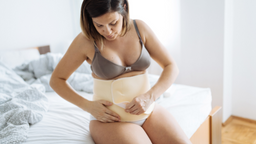During the transitional period called ‘postpartum’ or the ‘fourth trimester,’ there are many changes happening in your body. Your core muscles have done a lot of hard work to grow and bring your baby into the world, and they definitely need some TLC. Ligaments that have stretched and softened are now beginning to shrink and firm up. Your center of gravity has shifted again and your posture is being impacted by all the time spent lifting and holding your baby. All this on top of a lack of sleep is truly impressive!
Maternity Compression
Your abdominal muscles need a chance to stabilize and come back together to form a strong core to support you as you care for a new baby (and yourself!). The good news is there are plenty of ways to reinforce the work of your abdominal and pelvic floor muscles in the postpartum period, and ensure you are giving your body the support it needs to bounce back.
Many moms are familiar with some forms of maternity compression, like pregnancy support bands and compression socks. But they may be less familiar with how compression can help in the postpartum period. Like a pregnancy support band, a postpartum recovery garment provides gentle compression to the core, but extends to encompass the upper thighs, posterior, and the top of the abdomen as well.
A postpartum support garment is designed to address a litany of common postpartum issues. It supports your abdominal muscles, stabilizes joints, and encourages your organs to settle back into their normal positions. And seeing as you are now likely hunched over for a good portion of the day as you feed and care for your baby, a maternity compression garment comes in handy to help maintain good posture.
Maternity compression can also be used to help address the symptoms that go along with diastasis recti. Diastasis recti is the separation of the muscles along the middle of the abdomen that happens naturally during pregnancy to make room for a growing baby. A thin line of connective tissue called the linea alba lies between the two rows of abdominal muscle, and it stretches to allow the muscles to pull apart. After giving birth, often the connective tissue will shrink and tighten up, pulling the muscles back together.
While the condition sometimes corrects itself, sometimes it needs special attention. A study in the British Journal of Sports Medicine found that 60% of moms still had some separation of abdominal muscles at six weeks postpartum, and at 12 months postpartum, 32% still had mild diastasis recti. Persistent diastasis recti may appear as a ridge-like protrusion along the midline of the abdomen, and it may be more pronounced during abdominal straining. The use of a maternity compression garment is also helpful in bringing the abdominal muscles back together.
It’s important to keep in mind that the ultimate goal of compression is to provide good support, not to replace the work that your abdominal muscles are doing, nor to slim your waist. When a compression garment is a good fit, you should be able to keep breathing like you normally do. If you feel like you can’t walk, squat, or move around as usual then the garment may be too tight. A well-fitting garment should fit just tight enough to make you feel supported but not restricted. For those who have had c-sections, a zippered garment is best to keep the incision site protected when mom puts it on and removes it.
Postpartum Exercise
Exercise is a great tool to help strengthen and tighten stretched out muscles, improve or correct diastasis recti, and get you back into the swing of things. I get lots of questions about how and when to exercise after having a baby. It’s important to ask your provider if you have any concerns, as they know the particulars of you and your delivery and will be able to create a custom plan for you. Generally speaking, about two weeks after a normal vaginal birth is a good time to start incorporating daily practices like breathing exercises, pelvic tilts, kegels, walking, and arm/shoulder stretches.
As you start to resume your daily activities, it’s a good idea to wear your postpartum compression garment when you’re on your feet and active for longer than 15 minutes or so. The reason for this is that your pelvic floor and abdominal muscles are still not strong enough for the intra-abdominal pressure created by these activities. Pelvic floor prolapses and hernias can happen during the initial postpartum and one way to avoid that is to give those muscles external support until they are once again ready to support your core properly.
Always start slow! Listen to your body and if you notice any heaviness in your pelvis or if you can’t control your bladder, it’s a good idea to consult with your healthcare provider or a pelvic floor physical therapist.
About the Author
Rebekah Mustaleski is Compression Director with MotifMedical.com and a Certified Professional Midwife with Roots & Wings Midwifery in Knoxville, TN, where she promotes evidence-based maternity care for families seeking an out of hospital delivery. She is working to improve maternal outcomes during the childbearing year and to promote a sustainable business model for midwifery practices across the country. Rebekah is co-owner of Roots & Wings Midwifery, LLC as well as Treasurer for the Tennessee Midwives Association.



